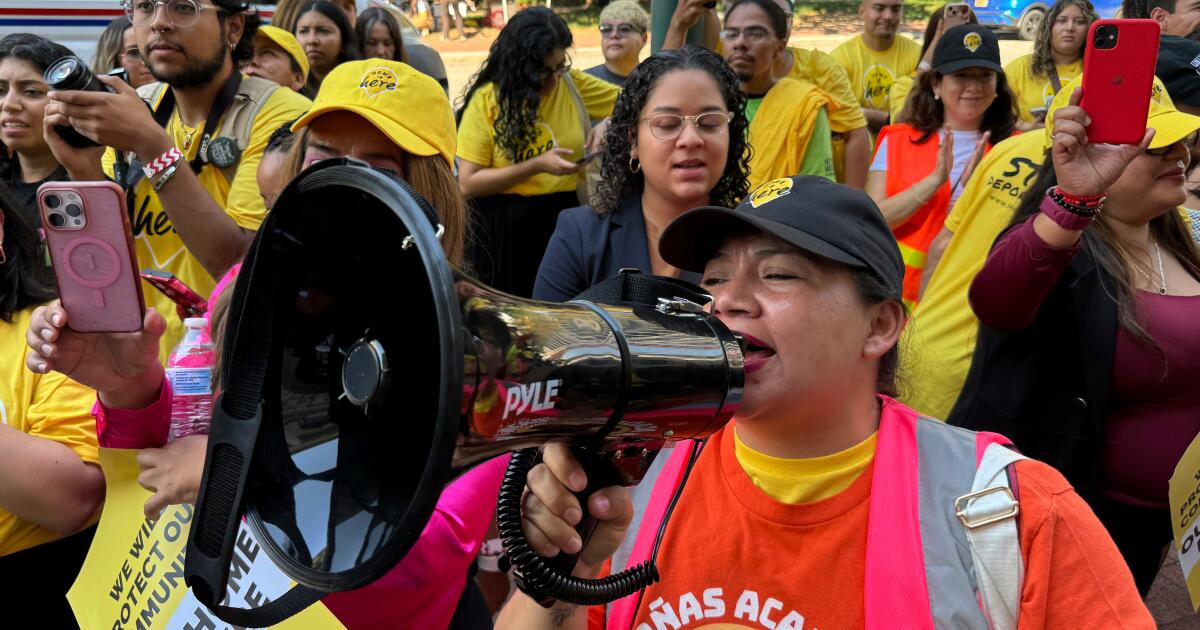Some DACA recipients have been arrested in Trump’s immigration crackdown
McALLEN, Texas — Yaakub Vijandre was preparing to go to work as a mechanic when six vehicles appeared outside his Dallas-area home. Federal agents jumped out, one pointed a weapon at him, and they took him into custody.
Vijandre is a recipient of Deferred Action for Childhood Arrivals, the Obama-era program that has shielded hundreds of thousands of people from deportation since 2012 if they were brought to the United States as children and generally stayed out of trouble. The Trump administration said it targeted Vijandre over social media posts. The freelance videographer and pro-Palestinian activist described his early October arrest to his attorneys, who relayed the information to reporters.
His arrest and several others this year signal a change in how the U.S. is handling DACA recipients as President Trump’s administration reshapes immigration policy more broadly. The change comes as immigrants have face increased vetting, including of their social media, when they apply for visas, green cards, citizenship, or to request the release of their children from federal custody. The administration also has sought to deport foreign students for participating in pro-Palestinian activism.
DACA was created to shield recipients, commonly referred to as “Dreamers,” from immigration arrests and deportation. It also allows them to legally work in the U.S. Recipients reapply every two years. Previously if their status was in jeopardy, they would receive a warning and would still have a chance to fight it before immigration officers detained them and began efforts to deport them.
In response to questions about any changes, Homeland Security spokesperson Tricia McLaughlin issued a statement saying that people “who claim to be recipients of Deferred Action for Childhood Arrivals (DACA) are not automatically protected from deportations. DACA does not confer any form of legal status in this country.” DACA recipients can lose status “for a number of reasons, including if they’ve committed a crime,” she said.
McLaughlin also claimed in a statement that Vijandre made social media posts “glorifying terrorism,” including one she said celebrated Abu Musab al-Zarqawi, Al Qaeda’s leader in Iraq who was killed in a U.S. strike in 2006.
An attorney for Vijandre, Chris Godshall-Bennett, said Vijandre’s social media activity is “clearly” protected speech. He also said the government has not provided details about the specific posts in court documents.
Vijandre is among about 20 DACA recipients who have been arrested or detained by immigration authorities since Trump took office in January, according to Home is Here, a campaign created by pro-DACA advocacy groups. The administration is seeking to end his DACA status, which could result in his being deported to the Philippines, a home he has not visited since his family came to the U.S. in 2001, when he was 14.
DACA has faced legal challenges
DACA survived the first Trump administration’s attempt to rescind the program when the Supreme Court ruled in 2020 that the administration did not take the proper steps to end it.
There have been other attempts to end the program or place restrictions on recipients.
This year, the 5th Circuit Court of Appeals issued a ruling that would deny work permits for DACA recipients who live in Texas. The Trump administration recently presented its plans to a federal judge who is determining how it will work.
The administration also has issued new restrictions on commercial driver’s licenses that would prevent DACA recipients and some other immigrants from getting them. Last year, 19 Republican states stripped DACA recipients’ access to health insurance under the Affordable Care Act. And the number of states where immigrant students can qualify for in-state tuition has dwindled since the Justice Department began suing states this year.
“This administration might not be trying to end DACA altogether the way that they did the first time around, but they are chipping away at it,” said Juliana Macedo do Nascimento, spokesperson for United We Dream, which is part of Home is Here, the coalition keeping track of public cases of DACA recipients who have been detained.
Detained DACA recipients question their arrests
Catalina “Xóchitl” Santiago Santiago, a 28-year-old activist from El Paso, was arrested in August despite showing immigration officers a valid work permit obtained through DACA.
Days later, federal officers arrested Paulo Cesar Gamez Lira as the 28-year-old father was arriving at his El Paso home with his children following a doctor’s appointment. Agents dislocated his shoulder, according to his attorneys.
Both Santiago and Gamez Lira were held for over a month while their attorneys petitioned for their release.
Marisa Ong, an attorney for Santiago and Gamez Lira, said the government failed to notify either of her clients of any intention to terminate their DACA status.
“DACA recipients have a constitutionally protected interest in their continued liberty,” Ong said, adding that “the government cannot take away that liberty without providing some valid reason.”
DACA recipients can lose their status if they are convicted of a felony, significant misdemeanors like those involving harming others, driving under the influence or drug distribution, or three or more misdemeanors. They can also lose their status if they pose a threat to national security or public safety.
DHS claimed in a statement that Santiago was previously charged with trespassing, possession of narcotics and drug paraphernalia and that Gamez Lira was previously arrested for marijuana possession.
Ong said that when attorneys sought their release “the government presented no evidence of any past misconduct by either individual.”
Vijandre, the Dallas-area man who was arrested in October, remains in a Georgia detention facility. His attorneys say he received notice two weeks before his arrest that the government planned to terminate his DACA status but that he wasn’t given a chance to fight it.
“I think that the administration has drawn a very clear line and at least for right now, between citizen and noncitizens, and their goal is to remove as many noncitizens from the country as possible and to make it as difficult as possible for noncitizens to enter the country,” Godshall-Bennett, Vijandre’s attorney, said.
Gonzalez writes for the Associated Press.


